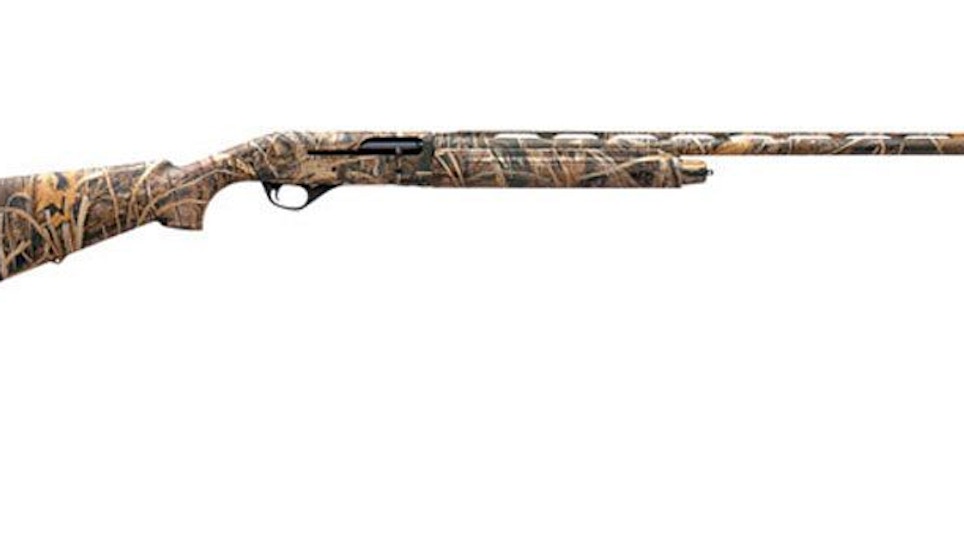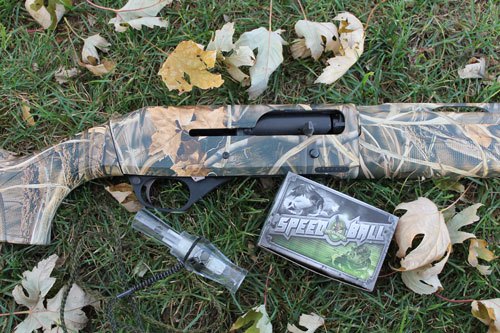The country of Turkey, like England and Italy before it, is emerging as a hot-seat of gun-making activity. While many Turkish-made shotguns are considered to be of the “economy model” variety, one brand — Stoeger — sits at the top of the heap.
Stoeger semi-autos are made in Turkey, but as a Benelli affiliate, they are powered by their Italian parent company’s proven and reliable Inertia Driven operating system.
Several years ago, I seem to remember reading somewhere that a Turkish firm had done such a good job of copying Benelli’s inertia operating system that, rather than suing for patent infringement, the Italian gun giant instead brought them into the fold where they could make some refinements and control quality. While my sources at Benelli haven’t confirmed or denied this story, the resulting shotgun was the M2000, released under the Stoeger label.
After over a decade in production, the M2000 has now been updated to the M3000 introduced last summer.
The Stoeger M3000 features several upgrades not found on the M2000, the most notable being the receiver, now drilled and tapped to accept a Weaver-style scope base; and the shim kit for customizing gun fit, four of which were included with my test gun.
Both the barrel extension and bolt have been beefed up for improved strength and reliability over the M2000. The M3000 bolt, in particular, has been redesigned with two large locking lugs and a rotating camming system similar to that found on the M3500, Stoeger’s 3 ½-inch chambered 12-gauge autoloader.
 The M3000 also features a streamlined fore-end cap, which has a positive gripping surface and integrated sling swivel stud. The redesigned forearm also effectively captures the spring washers, which reportedly could work loose and fall out on the old M2000.
The M3000 also features a streamlined fore-end cap, which has a positive gripping surface and integrated sling swivel stud. The redesigned forearm also effectively captures the spring washers, which reportedly could work loose and fall out on the old M2000.
Like the M2000, the M3000 is a 3-inch 12-gauge workhorse. A 3-inch chamber on an “economy” shotgun is appropriate, because if you don’t have much cash to spend on the initial gun purchase, you likely won’t have the funds required to feed it a steady diet of pricey super magnum ammo, either. Besides, 3-inch waterfowl loads will get the job done just fine. Also, the M3000’s magazine tube/forearm is shorter than the 3 ½-inch M3500’s, resulting in a trimmer, faster-handling scattergun. Indeed, with an average weight of just under 7 ½ pounds, the M3000 would be a great choice for the “one-gun hunter” looking for a combo waterfowl/upland smoothbore.
My test gun was fully dipped in waterfowl-worthy Max-4 camo and had a 26-inch barrel; a longer 28-inch barrel is also available. Other finishes include Realtree APG and basic black synthetic. No wood stock models are available at this time, but that’s ok, as I’ve grown fond of synthetic stocks, which handle the abuses hurled out over the course of a fowling season much better than wood.
The camo finish on my test gun, as on all the Stoeger’s I’ve examined, was flawlessly applied. This attribute alone speaks volumes about the quality of these Turkish-made firearms. In fact, Stoeger’s camo finishes are more expertly applied and resist fading better than some applications I’ve seen on much more expensive guns.
The molded checkering on the synthetic stock and forearm does a fine job of providing a sure grasp, and Stoeger’s blue “target” logo adorns the grip cap — an indication of the pride the company rightfully takes in its scatterguns. A thick recoil pad at the butt does a nice job of taming 3-inch magnum recoil, and an optional recoil reducer is also available as an accessory item.
The M3000 features an enlarged, redesigned trigger guard. The trigger on my test gun was a bit heavy, but I hope that will improve with increased usage. The safety is conveniently located where, in my opinion, it should be — behind the trigger. The trigger group is easily removed for cleaning by punching out a single retaining pin.
As on most autoloaders, the bolt release button is located on the right side of the receiver. It’s smooth and, like the safety button, a little on the smallish side, but it’s adequate, although some checkering or grooves would be nice.
The bolt handle is another matter. It is large, grooved, and shaped kind of like a feather. It’s the same bolt handle as found on the M3500, and is the best bolt handle shape and size I’ve seen on any semi-auto of any type, period.
The barrel features a wide, slightly raised vent rib, with a red bar front sight at the muzzle. To cut down on costs, only three standard Mobile-style chokes are included with the M3000 — IC, modified and turkey extra-full. The IC and modified tubes are both flush-mount, while the turkey choke is extended. Excluded are the cylinder and full chokes, both of which see limited usage in most wingshooting applications anyhow.
While testing the M3000, I used the modified choke, as will most waterfowlers most of the time. Since waterfowl season wasn’t yet underway, I did most of my shooting at clays and doves. Test loads on targets included Estate 1 1/8-oz. 7 1/2s at 1,200 fps, Winchester Super Target 1 1/8-oz. 7 1/2s at just 1,145 fps and X-pert Steel 1-oz. 7s at 1,325 fps, and Cheddite’s excellent 1-oz. load of 8 ½s at 1,250 fps. I busted far more clays than I missed, and there were no malfunctions, even with the low-velocity Winchester Super Target load, which caused several other gas-operated autoloaders I was also testing at the time to fail. For doves, I used Winchester Super Speed 1-oz. 7 ½s at 1,350 fps, which also functioned without a hiccup.
Hunters who want a reliable, inertia-operated autoloader but are unable to afford a pricey Benelli would do well to consider Stoeger’s semi-autos, particularly the new M3000. With a real-world price of only $450 for black synthetic, it represents an exceptional value, and for just 50 bucks more you can get one of the beautifully applied camo models. It might be stamped “Made in Turkey,” but the ducks won’t know the difference.







